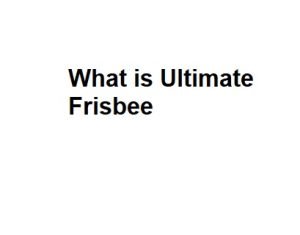Ultimate Frisbee, often simply referred to as “Ultimate,” is a non-contact team sport that combines elements of soccer, football, and basketball with the flying disc, commonly known as a Frisbee. It is a fast-paced and physically demanding game that is enjoyed by people of all ages and skill levels. In this guide, we’ll delve into the key aspects of Ultimate Frisbee, including its history, rules, equipment, and gameplay.

A Brief History of Ultimate Frisbee
Ultimate Frisbee was invented in the United States in the 1960s, and its origins are often credited to a group of high school students in Maplewood, New Jersey. The game’s informal beginnings gave rise to a set of rules and a sense of fair play that remain integral to Ultimate today. It wasn’t long before Ultimate Frisbee spread to college campuses and eventually across the world.
Key Rules of Ultimate Frisbee
- Objective: The primary objective of Ultimate Frisbee is to score points by catching the Frisbee in the opposing team’s end zone, similar to scoring a touchdown in American football.
- Teams: Each team typically consists of seven players on the field at a time, with the game being played on a rectangular field.
- Movement: Players cannot run while holding the Frisbee; they must establish a pivot foot and pass it to their teammates by throwing it.
- Scoring: A point is scored when a player catches the Frisbee in the opposing team’s end zone. The team with the most points at the end of the game wins.
- Turnovers: If the Frisbee is dropped, intercepted, goes out of bounds, or if a pass isn’t completed, possession is turned over to the opposing team.
- No Contact: Unlike many team sports, Ultimate Frisbee is non-contact. Players must avoid physical contact with opponents.
- Spirit of the Game: A core principle of Ultimate is the “Spirit of the Game,” emphasizing sportsmanship and fair play. Players are responsible for their own actions and are expected to resolve disputes on the field.
Equipment for Ultimate Frisbee
- Frisbee Disc: The central piece of equipment is the Frisbee disc, typically made of plastic and designed for optimal flight.
- Cleats: Many players wear cleats to provide traction on the field, especially in wet conditions.
- Jerseys: Teams often wear matching jerseys with numbers for identification.
Gameplay and Strategies
- Offense: Teams use a combination of cutting (sprint-like movements to get open) and throwing to advance the Frisbee toward the opposing end zone. Players must maintain a balance between short passes and long throws.
- Defense: Defensive players aim to prevent the offense from completing passes and force turnovers. This involves marking opposing players closely and intercepting or knocking down passes.
- Strategies: Teams employ various offensive and defensive strategies, including stack formations, zone defenses, and handler movements, to outmaneuver their opponents.
Advanced Techniques and Skills in Ultimate Frisbee
- Catching Techniques: Catching the Frisbee is a fundamental skill in Ultimate Frisbee. Players use a variety of catching techniques, including the two-handed catch, one-handed catch, and layout catches (where players dive horizontally to catch the disc). Catching under pressure and in different weather conditions is a skill that separates the best players from the rest.
- Throwing Techniques: Players must master various throwing techniques to become effective in Ultimate. Common throws include the forehand (or flick), backhand, hammer throw, and scoober. Precision, distance, and speed are crucial factors in successful throws.
- Cutting and Timing: Offensively, players must develop cutting skills to get open for passes. Timing is essential, as players need to coordinate their cuts with the thrower’s actions to create space and maintain possession.
- Zone Offense and Defense: In addition to individual skills, advanced players learn to excel in zone defense and offense. Zone defense involves players guarding specific areas rather than individual opponents, while zone offense focuses on exploiting gaps in the defense’s coverage.
- Handler Movement: Handlers are players who primarily handle the Frisbee and initiate offensive plays. Advanced handler movement and strategies include quick resets, handler dumps, and handler swings, which help maintain possession and reset the stall count.
Ultimate Frisbee Competitions
- Club-Level Tournaments: Competitive Ultimate players often join club teams, which participate in regional, national, and international tournaments. These tournaments attract top talent and feature highly skilled gameplay.
- College Ultimate: Many universities and colleges have Ultimate Frisbee teams that compete against each other in various leagues and championships. College Ultimate is often a stepping stone for players aiming to reach the highest levels of the sport.
- International Competitions: The pinnacle of Ultimate Frisbee includes international competitions like the World Ultimate Club Championships, World Ultimate and Guts Championships, and World Flying Disc Federation (WFDF) World Championships. These events showcase the best players and teams from around the world.
Ultimate Frisbee and Spirit of the Game
The “Spirit of the Game” is a central tenet of Ultimate Frisbee. This unique aspect of the sport places the responsibility for fair play and sportsmanship squarely on the shoulders of the players. Ultimate players are expected to be honest, respectful, and self-officiating. Disputes on the field are typically resolved through discussion between the players involved, rather than relying on referees.



